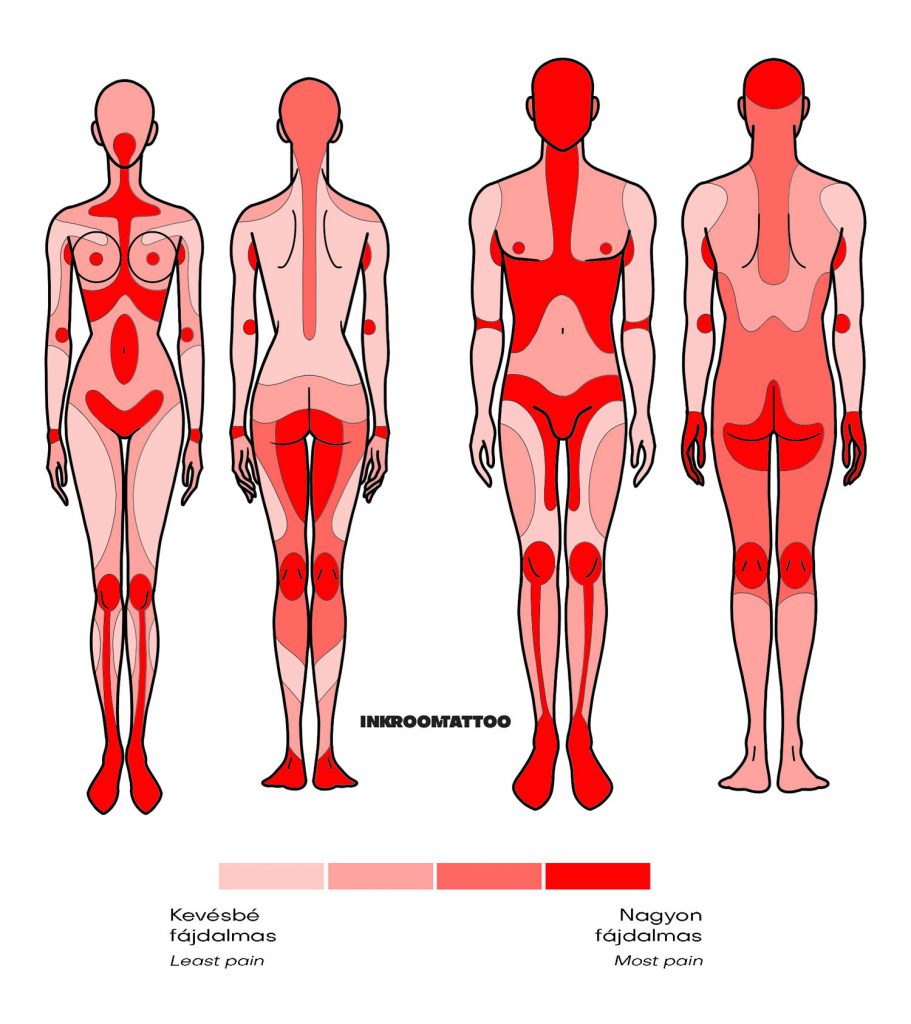This is one of the most common questions—especially before getting a first tattoo.
We’ve put together a guide based on our experience to help you better understand where tattoos tend to hurt the most (and least).
It’s a fact that everyone has a different pain threshold, and yes—tattooing involves pain, since pigment is injected into the deeper layers of the skin using needles.
We’d especially highlight areas where your joints are located: shoulder tips, elbows, wrists, knees, and ankles.
These spots tend to have thinner skin and it’s more uncomfortable when the needle taps directly onto the bone. The same applies to areas like the feet, hands, ribs, and sternum.
In general, the least painful areas are those with thicker skin, fewer nerve endings, and more fat underneath.
Of course, everyone experiences it differently, but we can say for sure that the location of the tattoo and even gender can influence how much it hurts.
Most Painful Areas:
- Armpits (lymph nodes and lots of nerve endings)
- Ribs (very thin skin, usually no fat underneath)
- Ankles & Shins (similarly thin-skinned like the ribs)
- Chest / Nipples (you feel the vibration through the ribs; nipples are extremely sensitive)
- Groin / Buttocks (very nerve-rich and thus highly painful)
- Elbows / Kneecaps (bone right under the skin, very sensitive)
- Back of the knees (high nerve concentration)
- Hips (more painful if you have a slimmer build)
- Neck / Spine (bone and nerve endings close to the surface)
- Head / Face / Ears (packed with nerves)
- Lips (nerve-dense and prone to bleeding and swelling)
- Hands / Feet (very thin skin, lots of nerves)
- Stomach (soft tissue, often more sensitive)
- Inner biceps (close to armpits and lymph nodes)
Least Painful Areas:
- Outer thighs (fatty area, low nerve density)
- Forearms (muscle and thicker skin, less nerve activity)
- Shoulders / Upper arms (thick skin, few nerves—possibly the least painful area)
- Calves (lots of muscle)
- Upper and lower back (thick skin, minimal nerves—except around the spine and hips)
As with many things, there are differences between men and women, and this tattoo pain map shows how pain points can vary between the two.

Other Influencing Factors: Age and body weight can also affect pain tolerance—older people usually tolerate pain less. The style of tattooing matters as well—a highly detailed, realistic design will usually be more painful than a simple piece. Some people find lining more painful, while others struggle more with shading.
What Does a Tattoo Feel Like?
Tattoo pain depends on where you get tattooed and how well you handle pain.
Many people ask what it compares to, so here’s a summary based on general experience:
A burning sensation, especially after the artist has worked in one spot for a while. For women, the feeling is often compared to epilating.
The body releases adrenaline during tattooing, which helps dull the pain (as it’s considered a type of “shock” to the body).
Fighting the pain only makes it worse. It’s best to distract yourself—listen to music or chat with your artist.
Outlining tends to be sharper and more painful than the shading, which uses different needle groupings.
Easing the Pain of Tattoos
If you’re worried about the pain—don’t stress!
Today there are various numbing creams and sprays available to help ease tattoo pain.
Look for them on tattoo supply websites or ask your artist about them.
While some say tattoos “should hurt” to be real, it’s totally acceptable to use pain relief if you prefer.
Some tips to help manage the pain:
Get plenty of rest before your session and eat a good meal beforehand.
Visualize the final design—when you really want something, you can endure a lot!
Be bold and get tattooed! The most important thing is to choose an experienced, professional artist who knows how to treat your skin with care. That’s something we can guarantee here at Inkroom Tattoo!


